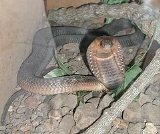
Egyptian cobra
Overview
Species
In biology, a species is one of the basic units of biological classification and a taxonomic rank. A species is often defined as a group of organisms capable of interbreeding and producing fertile offspring. While in many cases this definition is adequate, more precise or differing measures are...
in the genus
Genus
In biology, a genus is a low-level taxonomic rank used in the biological classification of living and fossil organisms, which is an example of definition by genus and differentia...
Naja
Naja
Naja is a genus of venomous elapid snakes. Although there are several other genera that share the common name, Naja are the most recognized and most widespread group of snakes commonly known as cobras. The genus Naja consists of 20 to 22 species, but has undergone several taxonomic revisions in...
found in Africa
Africa
Africa is the world's second largest and second most populous continent, after Asia. At about 30.2 million km² including adjacent islands, it covers 6% of the Earth's total surface area and 20.4% of the total land area...
and the Arabian Peninsula
Arabian Peninsula
The Arabian Peninsula is a land mass situated north-east of Africa. Also known as Arabia or the Arabian subcontinent, it is the world's largest peninsula and covers 3,237,500 km2...
. It is one of the largest Naja
Naja
Naja is a genus of venomous elapid snakes. Although there are several other genera that share the common name, Naja are the most recognized and most widespread group of snakes commonly known as cobras. The genus Naja consists of 20 to 22 species, but has undergone several taxonomic revisions in...
species in Africa.
The Egyptian cobra may grow to between 5 and 8 ft (1.5 and 2.4 m) in length. The most recognizable characteristics of an Egyptian cobra are its head and hood. The head is large and depressed with a broad snout. The cobra's eyes are large with round pupils. The colour is variable, but most specimens are some shade of brown, often with lighter or darker mottling, and often a "tear-drop" mark below the eye.
Unanswered Questions

